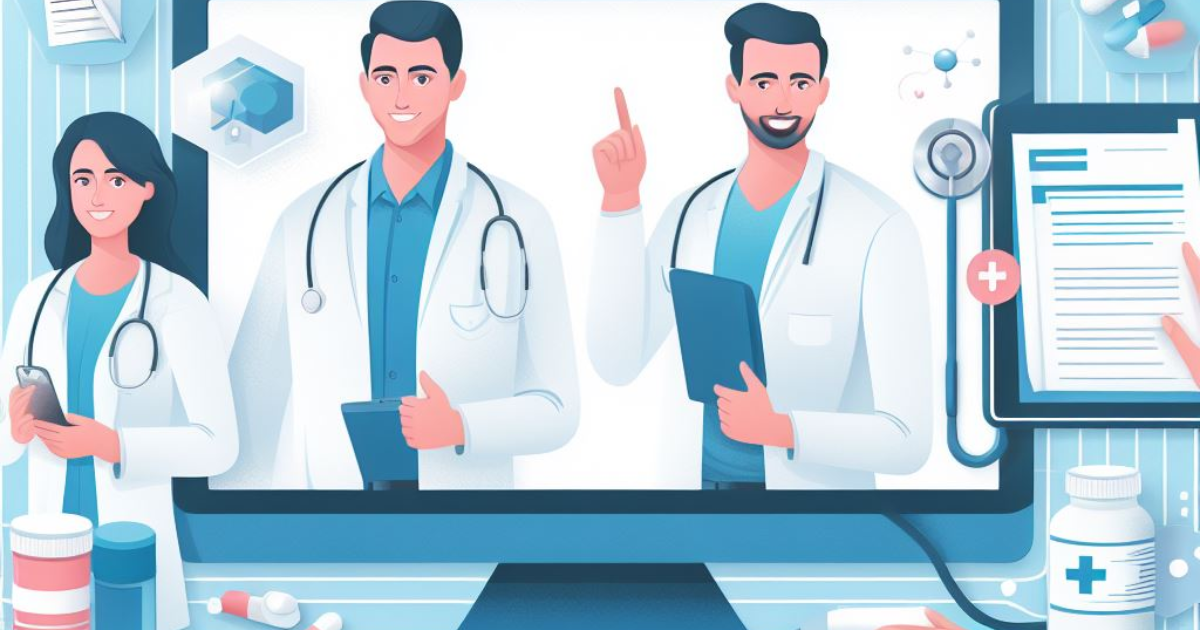Sharing is caring!

E-prescribing plays a crucial role in modern healthcare. This technology allows healthcare providers to electronically transmit prescriptions, enhancing patient safety and streamlining the medication process. Understanding its significance is essential for healthcare professionals.
What is e-prescribing and how does it differ from traditional prescribing methods?
E-prescribing, also known as electronic prescribing, refers to the process of electronically transmitting prescription information from healthcare providers to pharmacies. It involves the use of computer systems or software applications that allow healthcare providers to create, transmit, and manage prescriptions in a digital format. Unlike traditional prescribing methods which rely on handwritten or printed prescriptions, e-prescribing eliminates the need for paper-based prescriptions and manual processing. One key difference between e-prescribing and traditional prescribing methods is the speed and efficiency with which prescriptions can be transmitted. With e-prescribing, healthcare providers can send prescriptions directly to pharmacies in real-time, reducing the time it takes for patients to receive their medications. This not only improves convenience for patients but also enhances medication adherence. Another difference is the level of accuracy and completeness that e-prescribing offers compared to traditional methods. E-prescribing systems often include built-in checks and alerts that help healthcare providers avoid medication errors such as drug interactions or allergies. These systems can also provide access to comprehensive patient medication histories, allowing healthcare providers to make more informed decisions when prescribing medications. Overall, e-prescribing streamlines the prescription process by eliminating paper-based workflows and introducing automation and electronic communication between healthcare providers and pharmacies.
Why has e-prescribing become increasingly important in the healthcare industry?
E-prescribing has gained significant importance in the healthcare industry due to its numerous benefits and potential for improving patient care. One key driver behind its increasing adoption is its ability to enhance patient safety by reducing medication errors. Studies have shown that e-prescribing significantly reduces errors related to illegible handwriting or incorrect dosages, leading to improved patient outcomes. Additionally, e-prescribing helps improve medication adherence among patients. By providing electronic reminders or alerts for refills, patients are more likely to take their medications as prescribed. E-prescribing systems can also facilitate the electronic transmission of prescription information to mail-order pharmacies, making it easier for patients to receive their medications without having to visit a physical pharmacy. Another factor contributing to the importance of e-prescribing is its role in combating prescription drug abuse and fraud. E-prescribing systems can integrate with state prescription drug monitoring programs (PDMPs) to provide healthcare providers with real-time access to patients’ controlled substance history, helping them identify potential misuse or abuse patterns. Furthermore, e-prescribing improves operational efficiency for both healthcare providers and pharmacies. It reduces administrative burden by automating prescription-related tasks and streamlining workflows. This allows healthcare providers to spend more time on direct patient care and enables pharmacies to process prescriptions more efficiently. Overall, the increasing importance of e-prescribing in the healthcare industry stems from its ability to enhance patient safety, improve medication adherence, combat prescription drug abuse, and streamline workflows for healthcare providers and pharmacies.
How does e-prescribing streamline the medication ordering process for healthcare providers?
E-prescribing significantly streamlines the medication ordering process for healthcare providers by eliminating manual and paper-based workflows. Here are some ways in which e-prescribing achieves this:
Efficient prescription creation:
E-prescribing systems provide a user-friendly interface that allows healthcare providers to create electronic prescriptions efficiently. Providers can select medications from a comprehensive drug database, specify dosages and instructions, and include any necessary warnings or alerts. This eliminates the need for handwritten or printed prescriptions, saving time and reducing the risk of errors associated with illegible handwriting.
Real-time access to patient information:
E-prescribing systems often integrate with electronic health records (EHRs) or other databases, providing healthcare providers with real-time access to patient information. This includes demographic data, medical history, current medications, allergies, and more. Having this information readily available within the e-prescribing system eliminates the need to search through paper charts or contact other providers for necessary details.
Automated checks and alerts:
One of the key advantages of e-prescribing is its ability to perform automated checks and alerts during the prescription creation process. E-prescribing systems can flag potential drug interactions, allergies, or contraindications based on a patient’s medical history. These checks help healthcare providers make safer prescribing decisions by providing real-time warnings or reminders about potential risks.
Electronic transmission to pharmacies:
With e-prescribing, there is no need for healthcare providers to print prescriptions or rely on fax machines to transmit them to pharmacies. E-prescribing systems allow for direct electronic transmission of prescription information from healthcare providers to pharmacies in real-time. This eliminates delays associated with manual processing and ensures that pharmacies receive accurate prescription details without transcription errors.
Access to insurance formulary information:
Many e-prescribing systems integrate with insurance formulary databases, providing healthcare providers with real-time information about which medications are covered by a patient’s insurance plan. This helps providers select medications that are more likely to be approved and reduces the need for prior authorization requests. By having this information readily available within the e-prescribing system, healthcare providers can make informed decisions that align with insurance coverage. Overall, e-prescribing streamlines the medication ordering process for healthcare providers by eliminating manual tasks, providing real-time access to patient information, automating checks and alerts, facilitating direct electronic transmission to pharmacies, and integrating insurance formulary information into the prescribing workflow.
Benefits of electronic health records (EHRs) in facilitating e-prescribing
Improved accuracy and efficiency
EHRs (Electronic Health Records play) a crucial role in facilitating e-prescribing by improving the accuracy and efficiency of the process. With EHRs, healthcare providers can access comprehensive patient information, including medication history, allergies, and current prescriptions. This enables them to make informed decisions when prescribing medications electronically, reducing the chances of errors or adverse drug interactions. Additionally, EHRs can automatically check for potential drug allergies or contraindications, alerting healthcare providers to potential risks before prescribing a medication.
Streamlined communication and coordination
EHRs also enhance communication and coordination among healthcare providers involved in the e-prescribing process. Through secure messaging systems integrated within EHR platforms, prescribers can easily communicate with pharmacists to clarify prescription details or discuss any concerns. This real-time collaboration helps ensure that prescriptions are accurate and appropriate for each patient’s unique needs. Furthermore, EHRs allow for seamless sharing of patient information between different healthcare settings, such as hospitals and primary care clinics, enabling continuity of care and reducing duplication of efforts.
List of advantages provided by EHRs in e-prescribing:
- Access to comprehensive patient information
- Reduction in medication errors
- Automatic checks for drug allergies or contraindications
- Enhanced communication between prescribers and pharmacists
- Seamless sharing of patient information across healthcare settings
- Improved coordination among healthcare providers
An example scenario illustrating the benefits:
To better understand how EHRs facilitate e-prescribing, let’s consider a hypothetical scenario. Dr. Smith, a primary care physician, uses an EHR system to access Mr. Johnson’s medical records during a virtual consultation. Dr. Smith reviews Mr. Johnson’s medication history, allergies, and current prescriptions directly within the EHR interface.
Based on this information, Dr. Smith decides to prescribe a new medication for Mr. Johnson’s hypertension. As he enters the prescription details into the EHR system, it automatically checks for potential drug interactions and alerts Dr. Smith of a contraindication with one of Mr. Johnson’s existing medications.
Thanks to the prompt from the EHR system, Dr. Smith adjusts the prescription accordingly and sends it electronically to Mr. Johnson’s preferred pharmacy. The pharmacist receives the e-prescription through their own EHR system, which displays all relevant patient information and allows for secure messaging if clarification is needed.
In this scenario, EHRs enabled accurate prescribing by providing comprehensive patient information, ensuring patient safety by alerting healthcare providers to potential drug interactions, and facilitating seamless communication between the prescriber and pharmacist.
In conclusion, e-prescribing plays a crucial role in improving patient care and safety for healthcare providers. With its ability to streamline the prescription process, reduce medication errors, enhance medication adherence, and provide real-time access to patient information, e-prescribing has become increasingly important in the healthcare industry. By embracing electronic prescribing systems, healthcare providers can optimize workflows, improve patient outcomes, and contribute to a more efficient and effective healthcare system. Additionally, staying informed about the top trends in healthcare is essential as it helps professionals adapt to the ever-evolving landscape of healthcare technology and practices.




